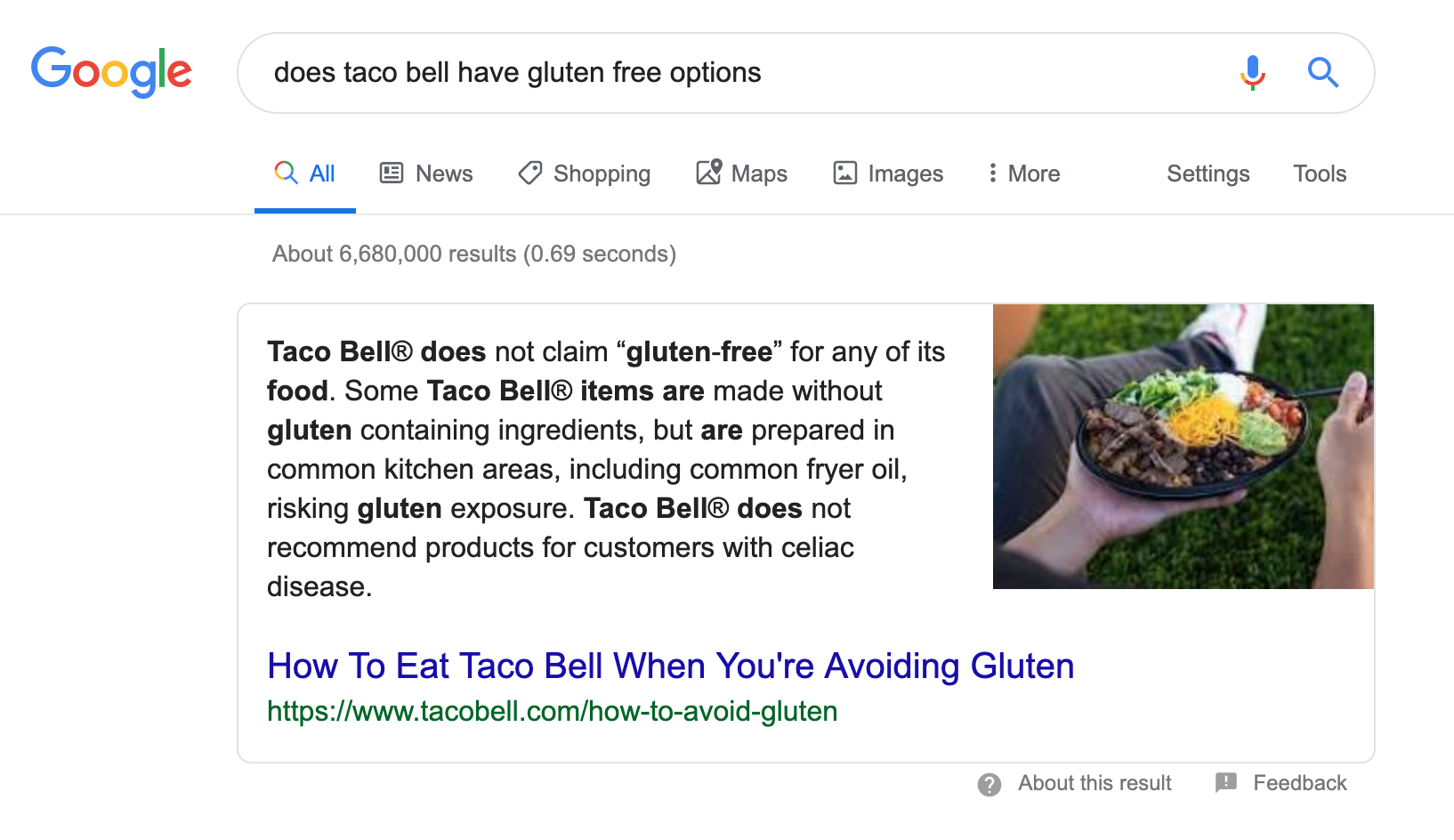State of Search
How To Rank For Featured Snippets
With search engines furnishing rich results at the top of search engine results pages (SERPs) — from the knowledge panel to the map pack — consumers today are more likely to expect answers to their queries without clicking through to a webpage. Featured snippets are a huge part of this. For example, if someone searches “does […]

With search engines furnishing rich results at the top of search engine results pages (SERPs) — from the knowledge panel to the map pack — consumers today are more likely to expect answers to their queries without clicking through to a webpage.
Featured snippets are a huge part of this. For example, if someone searches "does Taco Bell have gluten-free options?" this query is answered in a featured snippet result at the top of the SERP. Additionally, featured snippets are also the primary strategy for winning a share of voice search at present, as they are likely to serve a voice assistant's preferred answer.
Here's the Taco Bell example:
 You'll notice that the information in this featured snippet is pulled directly from the Taco Bell website. As a brand, this is exactly what you want — to be the source of truth about your own business everywhere customers are searching for information. But since search engine algorithms determine what information is pulled for rich results, this isn't always the case. Featured snippet information is often pulled from off-website sources like Wikipedia — and sometimes, it can even be wrong.
You'll notice that the information in this featured snippet is pulled directly from the Taco Bell website. As a brand, this is exactly what you want — to be the source of truth about your own business everywhere customers are searching for information. But since search engine algorithms determine what information is pulled for rich results, this isn't always the case. Featured snippet information is often pulled from off-website sources like Wikipedia — and sometimes, it can even be wrong.
Google has never issued a comprehensive guide to exactly how its featured snippets are sourced. But based on advice from SEO experts, here's what you can do to improve your chances at appearing as a featured snippet when a customer asks a question related to your brand.
Answer customer questions on your website.
The first step for brands is to ensure that the information on their own website (and all subsidiary or local pages, if applicable) is correct and comprehensive. This seems like an obvious first step, given that you can't answer a simple query about whether your business is "open now" if your hours are unlisted or incorrect. However, as search engines have become capable of answering more complex questions, consumers have been reconditioned to expect this level of specificity — and your brand doesn't stand a chance if your website itself isn't able to provide these types of answers.
Answer multidimensional customer questions on your website.
To use the Taco Bell example again, the query "does Taco Bell have gluten-free options" contains multiple pieces of information — it is asking about Taco Bell, but a particular entity (menu items) with a particular attribute (gluten-free). Google is able to pull this answer in a featured snippet because Taco Bell has structured its site so that these questions are answerable, and this information is interrelated and marked up in such a way that it is intelligible to Google.
Build your brand knowledge graph.
There is currently no markup specific to featured snippets. But using a structured data markup like Schema will put the content on your website into terms that search engines can understand. Having your pages marked up in this way increases the chances of them being crawled and "understood" by search engines — and helps you to surface in the kind of rich results we're talking about.
This is also the reason that having a brand knowledge graph is invaluable when it comes to "speaking the language" of search engines. Since search engines use a knowledge graph with bi-directional, flexible relationships, your brand should structure and store its data in the same way. By doing so, search engine knowledge graphs can draw on the personal knowledge graph that you maintain — allowing you to manage your information at scale and deliver the answers customers want, both on your own site and via third-party experiences.
Be the authority on your brand.
If Wikipedia has the most comprehensive and clear information about your brand, then search engines will likely pull from that source. Of course, you should ensure that your brand information is listed correctly across all sites that Google's algorithm might crawl (including Wikipedia) to ensure the most consistent experience possible. But if your website is clear, comprehensive, and able to answer complex questions — based on a knowledge graph where all of your facts and entities are stored — it appears more likely that the search engine algorithm will pull content from your website to populate its rich results.
Learn how your business can deliver brand-verified answers in search results with Yext.
